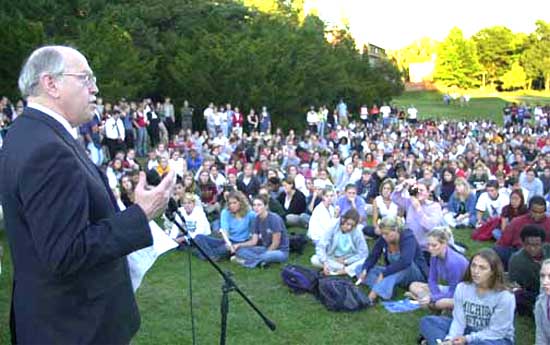
The MSU presidency has become a high-profile post because of President M. Peter McPherson's international presence
'U' to use Big Ten to spawn ideas
Trustees to assess other schools for search methods
By ELIZABETH PIET
The State News
MSU officials say the Board of Trustees will begin collecting information from other universities and discuss presidential searching methods at its June meeting.
MSU likely will evaluate two other Big Ten schools that appointed presidents in 2003 - Indiana University and the University of Iowa.
Both universities used a professional search agency to identify candidates and an appointed committee of faculty and trustees to review the applications.
"There's a lot of decisions," Trustee Donald Nugent said. "Certainly one of the options would be to hire a head-hunter - a search organizer."
If they choose not to use an agency, Nugent said board members could advertise the position themselves.
Nugent said he isn't worried about finding a new president before Jan. 1, the day after McPherson's tenure as MSU's top official ends.
The MSU presidency has become a high-profile post because of President M. Peter McPherson's international presence, Nugent said.
"I expect the word is out right now," he said.
The nine-member board of trustees at Indiana collected input from its eight separate campuses about the desired qualities in a president. In addition, it appointed an 18-person committee to sort through the applications generated by a search firm.
"The search committee determined what the final attributes were," said Ken Beckley, president of the Indiana University Alumni Association, who served on the committee.
"When you get down to it, you're looking for someone who can walk on water," he said.
For Indiana, it was someone who understood the university's needs and could lead the Hoosiers.
Beckley said the committee reduced the number of candidates to less than a dozen and interviewed them in an airport hotel in Chicago.
"We were very deliberate and tried to protect the identities of the candidates," he said. The final candidates' names were submitted to the full board of trustees and their names were revealed to the public.
MSU trustees also have stated candidates' names will remain confidential until the final stage. In 1993, the Michigan Supreme Court ruled that the Open Meeting Act does not apply to university presidential searches, as result of MSU's last hiring of its chief executive.
The Indiana committee began in January and the president was named Aug. 1, 2003, Beckley said.
The University of Iowa used a professional search firm and had a 26-member committee, said law Professor Jonathan Carlson who chaired the committee.
The search began in July 2002 and ended in January 2003.
"We did it in six (months), but that was a little quick," Carlson said, adding he thought it would be difficult for MSU to complete a search in eight months.
The process is difficult, but exciting, for candidates, too.
James Spaniolo, former dean of MSU's College of Communication Arts and Sciences and member of the State News Board of Directors, took office as the president of the University of Texas at Arlington in February.
Spaniolo said both interviewers and candidates have to ask many questions before a decision is made. From the beginning of the search to his selection, it took about six months.
"It was challenging, invigorating and stressful all at the same time," Spaniolo said. "What was strange about it was that you knew at any given moment, your candidacy could be over."
Elizabeth Piet can be reached at pieteliz@msu.edu.
